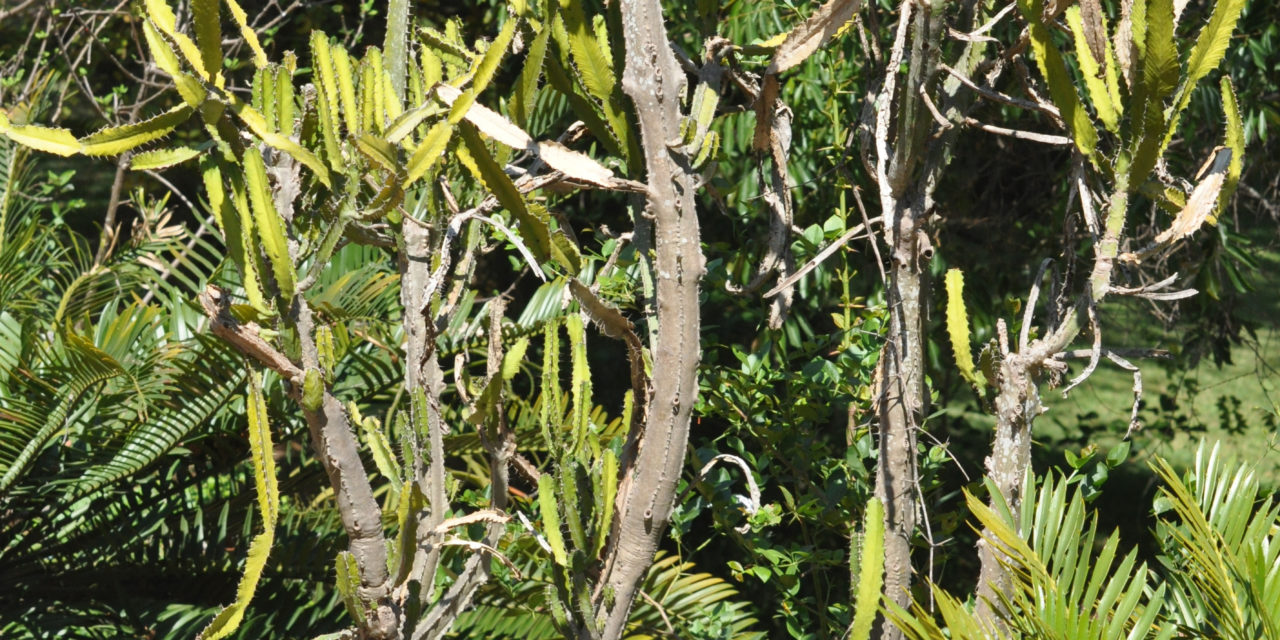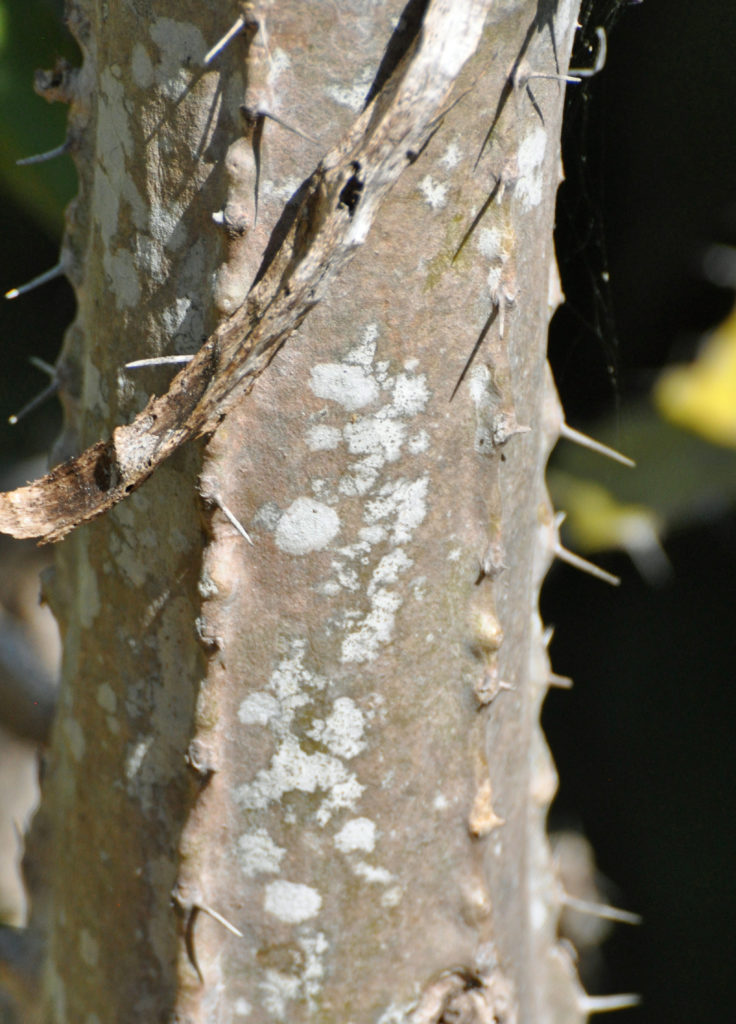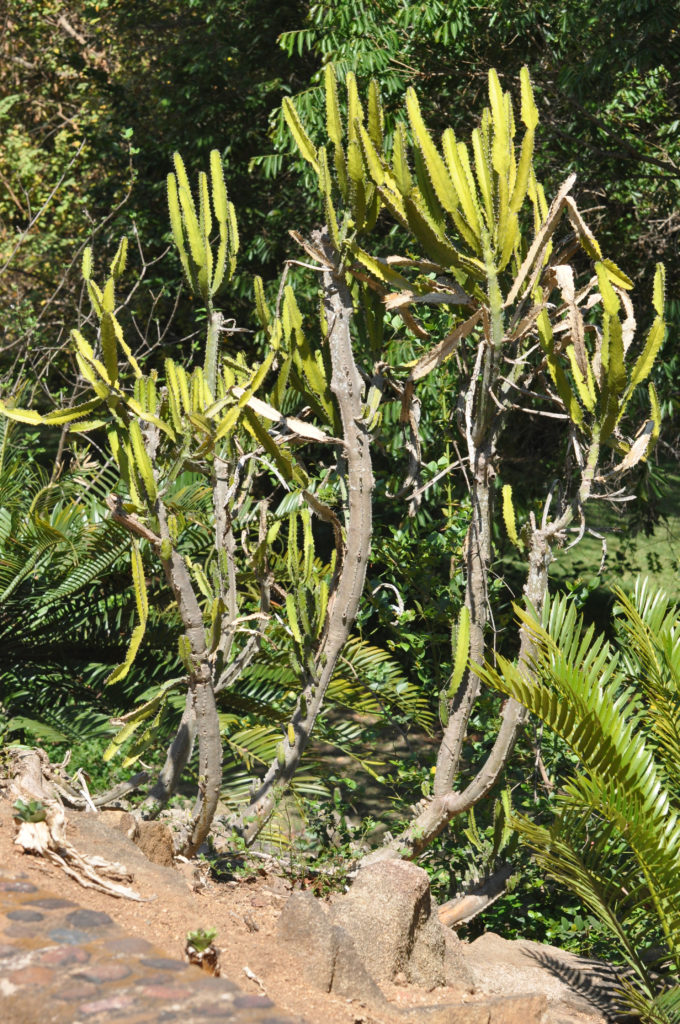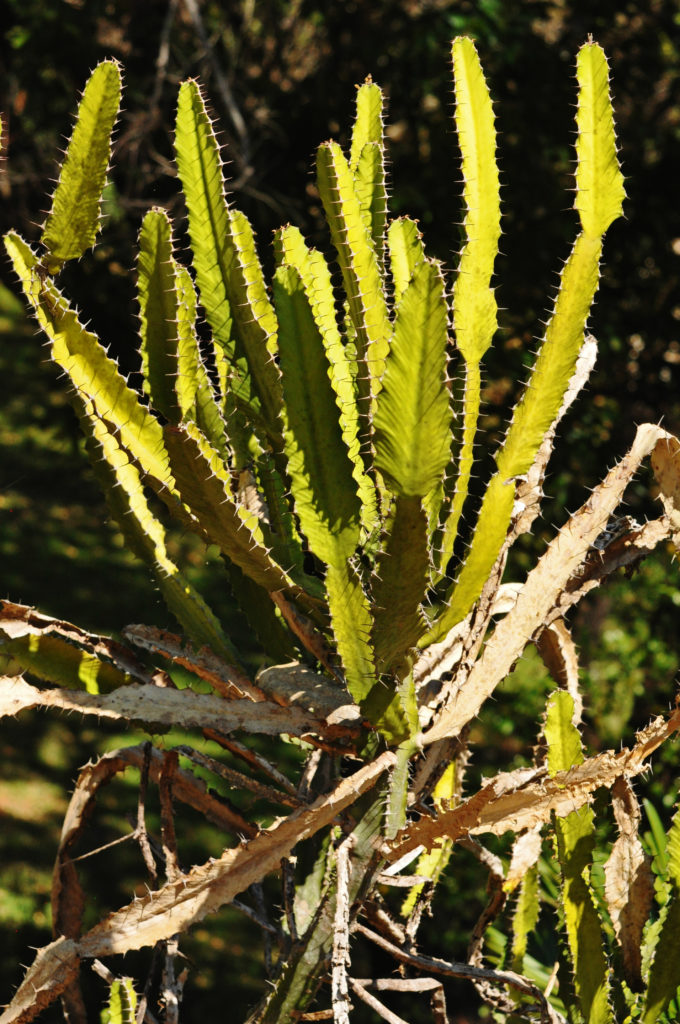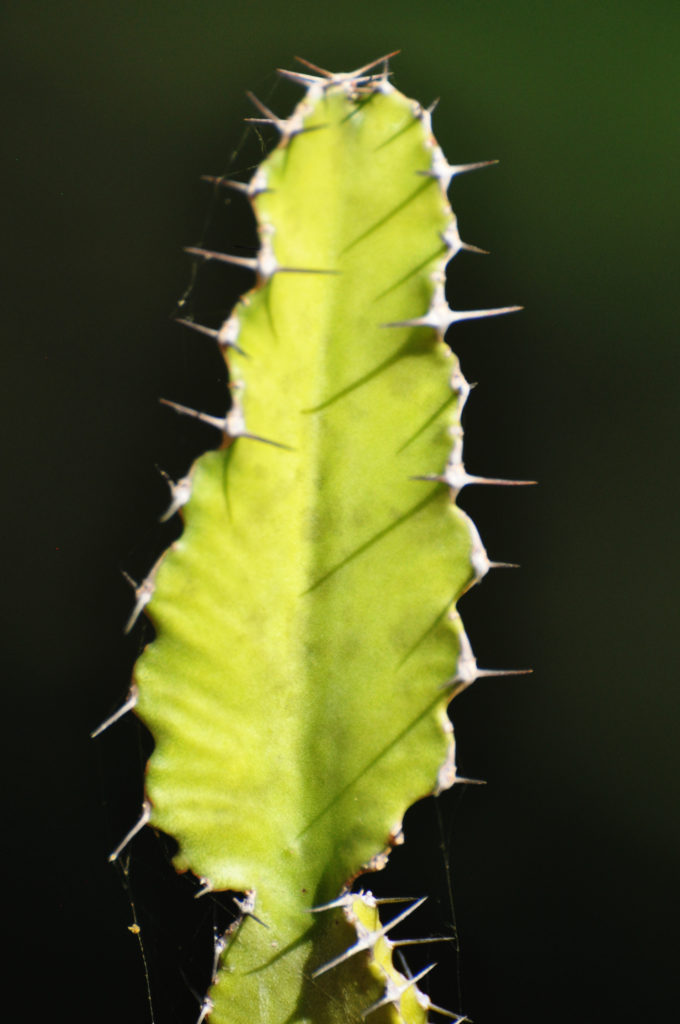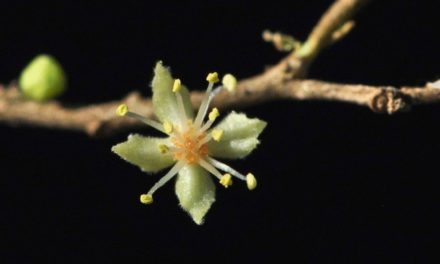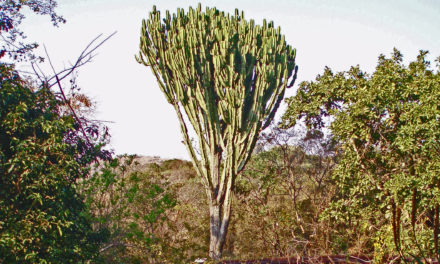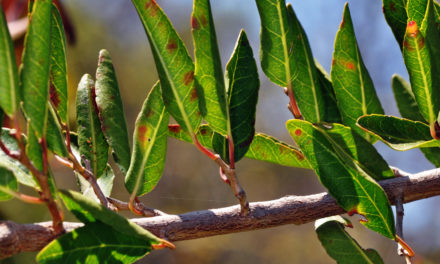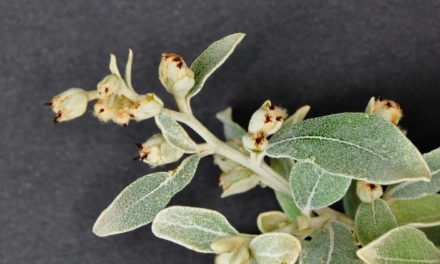General Info – summary
This Tree with 3-5 angled branches may reach 18m high. More than 1 stem-like branches may develop. Branchlets curve upwards, forming a candelabra-like head. Paired spines along margins on spine shields. Young, green stems replace Leaves for photosynthesis. Small yellowish, unisexual Flowers in cyathia & lack a perianth and have reduced single flowers: 1 female & many males. Fruit is a stalked 3-lobed capsule.
Description
Euphorbia triangularis
Previous Name: Euphorbia evansii.
SA Tree No. 356.
Common names: (Afr) Driehoek-melkbos, Naboom, Noorsdoring, Rivier-naboom, Riviernaboom. (Eng) Chandelier Tree, River Euphorbia, Three-angled Euphorbia, Tree Euphorbia. (isiXhosa) Umhlonthlo. (isiZulu) Inhlonhlwane, Isiphapha, Umhlonhlwane. (siSwati) Umhlonhlo.
Family Euphorbiaceae (Euphorbias family e.g., the exotic poinsettia – Euphorbia pulcherrima). This family has about 275 genera and 7 500 species with a very wide distribution. In South Africa, there are 50 genera and 484 species. Apart from Antarctica, members of this family are present in all continents. This family has many herbs, and in the tropics, shrubs and trees, including succulents and climbers, are more common. Local tree containing genera on this website include Croton, Euphorbia, and Spirostachys. Leaves, when present, are usually alternate, and simple. Stipules usually appear as hairs, glands or spines. The regular plants may be monoecious or dioecious. Inflorescences are situated terminally or in leaf axils. They are mostly in cymes (a broad, more or less flat-topped, determinate flower cluster, with central flowers opening first). Colourful bracts may be present below the flowers.
Name derivation: Euphorbia – named by Carl Linnaeus (who developed the Binominal system of classification) after Euphorbus: physician to the king of Mauritania (NW Africa) in 10 B.C. triangularis – referring to the ends of stems that are triangular in cross section. This possibly occurred before other further north trees were found – with between 3 and 5 angles.
Conservation: National Status: L C. (Least Concern). Assessment Date: 2005 (R.H. Archer and J.E. Victor).
Tree
This distinctly succulent Tree trunk may reach 10-17m high (usually less) and 9cm wide. It has an almost cylindrical Trunk that is slightly 4 angled (photo 828). The Bark that remains on the main trunk is grey (photo 828). More than 1 stem like Branch may develop. The yellow-green or green and slender Branchlets (small branches or division of a branch – especially a terminal divisions and usually apply to branches of the current or preceding year). These branchlets are up to 8cm in diameter, and divided into segments up to 30cm long. They are 3-5 angled (usually 3 in the south and 4-5 angled away from the Cape. They curve upwards forming candelabra shaped heads at the ends of branches (photo 830) – hence the common name “Chandelier Tree”. The younger branchlets are green and undergo photosynthesis – replacing leaves for this function (photo 827). The paired, diverging, simple, brown/grey and up to 8mm long Spines are situated along the parallel margins on Spine shields that may, or not, link with those above or below (photo 829). When they do connect, they make a horny margin. The spiny branchlet margin may be uneven and wavy (photo 829). As the tree grows, the lower branches die off and fall.
- 828. 2014/09/00/15 Lowveld NBG. Photo: David Becking.
- 830. 2014/09/15. Lowveld NBG. Photo: David Becking.
- 827. 2014/09/15. Lowveld NBG. Photo: David Becking.
- 829. 2014/09/15. Lowveld NBG. Photo: David Becking.
Flowers
The Flowers lack a perianth (calyx and corolla) and occur in an inflorescence called a Cyathium (a cup-shaped inflorescence that appears to be a single flower, but is actually a collection of reduced flowers). Cyathia develop on the ridges – just above the spines. In the centre of the cyathium is a single unisexual Female Flower that consists of a single Pistil (with a single trilocular, superior ovary, from which the style divides into 3 with each division ending in a receptive Stigma). Surrounding the central single female flower are a number of Male Flowers. Each Stamen is a complete male flower and has a single Filament supporting a single pollen-producing Anther with 2 theca (pollen sacs). The exterior of each cyathium is surrounded at the base not by sepals or petals but by 5 bracteoles (small-united bracts – usually much-reduced specialised leaves, particularly the small scale like leaves in a flower cluster or associated with flowers). Their upper tips are free and initially cover the opening of the involucre (a ring or whorl of bracts immediately below the flowers). The male and female flowers do not produce their own nectar. Separate, often brightly coloured Nectar Glands on the bracteoles produce a great deal of nectar and carry out this function. Collectively the nectar and the coloured bracteoles attract many insects, which become the agents of pollination. (Jun-Aug).
Fruit
The mature, woody Fruit is a 3-lobed Capsule (a dry fruit resulting from the maturing of a compound ovary that usually opens at maturity by one or more lines of dehiscence). It is up to 8mm in diameter and rests on a curved stalk that may reach 6mm long. The capsule becomes red when mature and dehisces releasing the seeds. (Jul-Oct).
Distribution & Ecology
These Trees often grow densely together and thrive in arid areas on rocky hillsides and along tidal rivers just above the riverbanks. Closer to the coast the plants occur more densely but do occur up to an altitude of 1 700m. This drought resistant tree stores water in swollen stems and branches. They are most abundant in the Eastern Cape where it is the most common Euphorbia tree. They extend eastwards from Kariega (Uitenhage) and Bedford. Here the stem is usually 3-angled and can be seen in Van Staden’s Pass (N2 – West of Port Elizabeth, and near the mangrove swamps close to the Kobonqaba River mouth – about 15km NE of Morgans Bay. This is the most southern mangrove community in Africa. This extremely adaptable plant grows together with the mangrove trees. Euphorbia triangularis is also located in KwaZulu-Natal, Mpumalanga, Swaziland and southern Mozambique. In KwaZulu-Natal, stems are usually 5-angled. Roots penetrating into brackish water are not a problem as the salt concentration restricts the amount of useable water absorbed and thus availability is similar to that in arid areas. Canaries consume the Seeds on the tree and doves eat the fallen seeds. The Wood is light, soft and useful. An unsuccessful attempt was made to extract and market rubber. Unfortunately, the quality of the rubber was poor. These plants have been grown in Europe since the 1800’s.
Ethnobotany
Propagation is by seeds and cuttings. Note: The Sap is extremely poisonous. Wash any body part contact with sap with large quantities of water as soon as possible. The soft Wood is of a low density but is useful. Traditionally Eastern Cape Xhosa people plant trees for new twin births. These plants can be grown from seeds planted in spring or summer, or from cuttings. Water sparingly to encourage vertical growth.
References
Archer, R.H. & Victor, J.E. 2005. Euphorbia triangularis Desf. National Assessment: Red List of South African Plants version 2020.1. Accessed on 2023/05/26.
Boon, R. 2010. Pooley’s Trees of eastern South Africa. Flora and Fauna Publications Trust, Durban.
Burrows, J.E., Burrows, S.M., Lotter, M.C. & Schmidt, E. 2018. Trees and Shrubs Mozambique. Publishing Print Matters (Pty) Ltd. Noordhoek, Cape Town.
Coates Palgrave, M. 2002. Keith Coates Palgrave Trees of Southern Africa, edn 3. Struik, Cape Town.
Lawrence, G. H. M, 1951. Taxonomy of Vascular Plants, The Macmillan Company, New York. Tenth Printing 1965.
Palmer, E. & Pitman, N. 1972. Trees of southern Africa, Balkema, Amsterdam, Cape Town.
Schmidt, S. Lotter, M. & McCleland, W. 2002. Trees and Shrubs of Mpumalanga and the Kruger National Park.
van Wyk, B. & van Wyk, P. 1997 Field guide to Trees of Southern Africa, Struik, Cape Town.
http://witbos.co.za/plant.aspx?plant=euphorbia-triangularis
http://desert-plants.blogspot.co.za/2010/07/euphorbia-triangularis.html
https://www.ispotnature.org/species-dictionaries/sanbi/Euphorbia%20triangularis
http://posa.sanbi.org/flora/browse.php?src=SP

